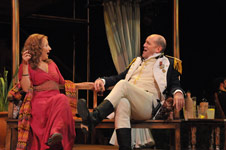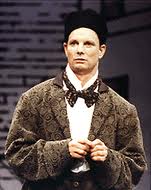 Baseball was clearly in the air at San Francisco Opera yesterday afternoon. Besides the fact that a few of the journalists present at the press briefing with Placido Domingo had just come from the ballpark where, among other things, they had heard the actress Zooey Deschanel sing “God Bless America,” there seemed little real reason for that to be the case.
Baseball was clearly in the air at San Francisco Opera yesterday afternoon. Besides the fact that a few of the journalists present at the press briefing with Placido Domingo had just come from the ballpark where, among other things, they had heard the actress Zooey Deschanel sing “God Bless America,” there seemed little real reason for that to be the case.
Nevertheless, sports analogies flew backwards and forwards at the briefing like we were watching a commentary from the ballpark rather than listening to one of the world’s greatest living singers discussing opera.
At one point, Domingo compared the job of a tenor to that of a pitcher in a baseball game. At another, David Gockley spoke of the doubts that television executives had about airing professional sports on TV back in the day and compared it to the doubts that they have about putting opera on the small screen today. Domingo’s final statement went something like this: “My dream is that see the opening night of the season at San Francisco Opera or La Scala or The Met from their home.”
I know that Domingo is a sports fan and that SF Opera has enjoyed a partnership with the local ballpark over the past five years with its free outdoor simulcasts of productions beamed to audiences of more than 30,000 from the War Memorial Opera House. But the press event overemphasized the power of the Great Game a little too heavily for my taste.

 The journalist Farhad Manjoo (one of my favorite commentators on new media and technology in general) has written a
The journalist Farhad Manjoo (one of my favorite commentators on new media and technology in general) has written a  I am just about to go off the grid for a few days and am in a festive mood. So I thought I would regale my readers with some terrible jokes about choirs that I dug up on a whim while procrastinating on the Internet recently. I’ll be back in the blogging saddle next week sometime. For now, read these and be happy you’re not a chorister. Or if you are, be happy you have a sense of humor about it…
I am just about to go off the grid for a few days and am in a festive mood. So I thought I would regale my readers with some terrible jokes about choirs that I dug up on a whim while procrastinating on the Internet recently. I’ll be back in the blogging saddle next week sometime. For now, read these and be happy you’re not a chorister. Or if you are, be happy you have a sense of humor about it… By far the best thing about attending
By far the best thing about attending  It’s gotten to the point where hearing about how fed up people are about the decline of arts reviews in the press is becoming boring and not helpful in terms of finding a solution to replace the loss.
It’s gotten to the point where hearing about how fed up people are about the decline of arts reviews in the press is becoming boring and not helpful in terms of finding a solution to replace the loss. I just got the following email from a friend about In the Red and Brown Water, the first part of The Brothers/Sisters Plays, a trilogy of dramas by Tarell Alvin McCraney (pictured). The trilogy is currently being rolled-out in three Bay Area theatres:
I just got the following email from a friend about In the Red and Brown Water, the first part of The Brothers/Sisters Plays, a trilogy of dramas by Tarell Alvin McCraney (pictured). The trilogy is currently being rolled-out in three Bay Area theatres: I’ve devoted several episodes of
I’ve devoted several episodes of  A few months ago, following a trip out to Orinda to see G B Shaw’s Mrs Warren’s Profession at the
A few months ago, following a trip out to Orinda to see G B Shaw’s Mrs Warren’s Profession at the  As a theatre critic, I generally have a policy that if I find myself feeling negative about the work of a single company over several shows, I’ll give seeing productions by that company a break and then go back and check another show out after some time has elapsed. This helps to “reset the clock” so to speak. There’s no point in harping on over and over again about how terrible one organization’s work is. That gets dispiriting and discouraging for readers and writer alike. It tends to annoy the artists too.
As a theatre critic, I generally have a policy that if I find myself feeling negative about the work of a single company over several shows, I’ll give seeing productions by that company a break and then go back and check another show out after some time has elapsed. This helps to “reset the clock” so to speak. There’s no point in harping on over and over again about how terrible one organization’s work is. That gets dispiriting and discouraging for readers and writer alike. It tends to annoy the artists too.  1. More opera websites should provide information about their choruses. Notices about auditions and lists of singers don’t provide enough detail about how these important musical organizations work. I’d like to see opera websites publishing information about the history and development of their choruses, important milestones in their pasts, production photos, information about life backstage for chorus members and what it’s like to audition and rehearse with an opera chorus. I say this because I just recorded a
1. More opera websites should provide information about their choruses. Notices about auditions and lists of singers don’t provide enough detail about how these important musical organizations work. I’d like to see opera websites publishing information about the history and development of their choruses, important milestones in their pasts, production photos, information about life backstage for chorus members and what it’s like to audition and rehearse with an opera chorus. I say this because I just recorded a  I dropped in to a bar on Polk Street last night when the weekly pub quiz was in full flight. I’ve played a couple of quizzes in bars in my time, but it wasn’t until I experienced this is as a sort of semi-player, semi-viewer, that I really got to appreciate how lively these kinds of events are from a cultural perspective.
I dropped in to a bar on Polk Street last night when the weekly pub quiz was in full flight. I’ve played a couple of quizzes in bars in my time, but it wasn’t until I experienced this is as a sort of semi-player, semi-viewer, that I really got to appreciate how lively these kinds of events are from a cultural perspective.